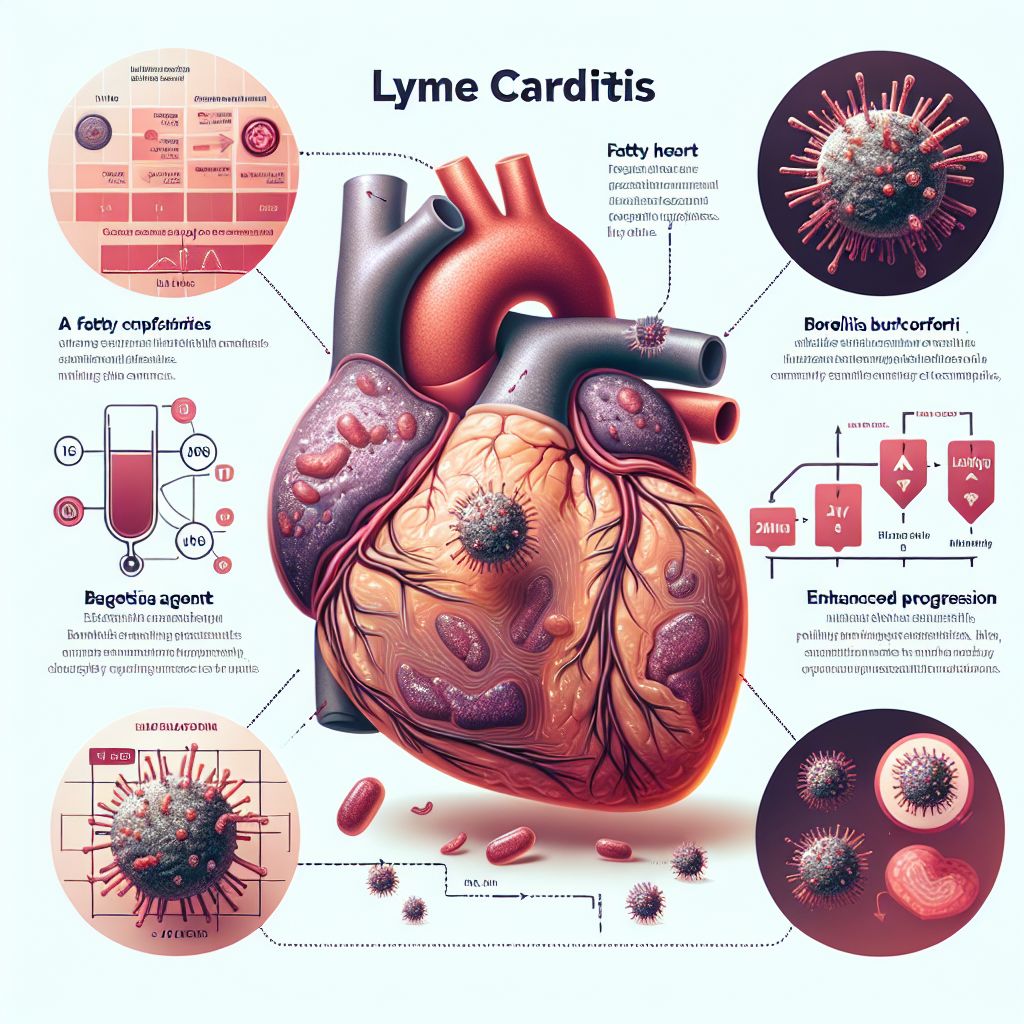-
Lyme carditis can lead to serious heart complications, including heart block.
-
Fatty heart, often caused by insulin resistance, can exacerbate inflammation and increase the severity of cardiac issues.
-
Recognizing early symptoms of Lyme carditis is crucial for timely intervention.
-
Preventative measures can reduce the risk of developing severe Lyme carditis in individuals with fatty heart.
-
Lifestyle changes and medical interventions are key to managing the dual risk of Lyme disease and fatty heart.

Lyme Carditis: Understanding the Risks
When you hear the words ‘Lyme disease,’ you might think of joint pain or fatigue. But there’s a less talked-about aspect of this condition that’s vital to understand: Lyme carditis. It’s a serious complication that can sneak up on you, and in my two decades of guiding patients through Lyme disease, I’ve seen how critical it is to catch it early.
What Is Lyme Carditis and Who Is at Risk?
Lyme carditis occurs when Lyme disease bacteria, Borrelia burgdorferi, affect the heart by infecting the heart. This can happen to anyone infected with Lyme disease, but not everyone’s risk is equal. But most importantly, if you have a fatty heart, which is often the result of insulin resistance, your heart can become much more inflamed, magnifying any other issue, including Lyme carditis.
Recognizing the Symptoms of Lyme Carditis
The early signs of Lyme carditis can be subtle, but they’re there if you know where to look. Watch out for:
-
Light-headedness or fainting
-
Heart palpitations or chest pain
-
Shortness of breath
-
Unexplained fatigue
These symptoms can be easily dismissed as something less serious, but they’re your body’s way of waving a red flag.
When to Seek Medical Attention
If you’re experiencing any of these symptoms, especially after a tick bite seek medical attention because Lyme carditis can progress to complete heart block, which might require a pacemaker to correct.
The Dangers of Fatty Heart
Defining Fatty Heart: Causes and Consequences
Fatty heart, which is a manifestation of non-alcoholic fatty liver disease (NAFLD), is often a silent condition where fat accumulates around the heart due to insulin resistance. This isn’t just about having a little extra weight; it’s a serious condition that can lead to heart failure if left unchecked.
-
Insulin resistance increases the risk of fatty heart.
-
Fatty heart can lead to heart failure and magnifies other heart conditions.
-
Managing insulin resistance is key to preventing fatty heart.
But what does this have to do with Lyme disease? A lot, actually. The inflammation from a fatty heart sets the stage for a more severe reaction if Lyme disease enters the picture.
Connection Between Fatty Heart and Lyme Carditis
Understanding the link between a fatty heart and Lyme carditis is crucial for those at higher risk. The heart is an organ that thrives on balance and health, but when it’s covered with excess fat, its ability to manage additional stressors—like an infection from Lyme disease—is compromised. That’s because that fat around the heart is giving off inflammatory chemicals right into the heart, pouring fuel on a fire.
Exacerbating Inflammation: Fatty Heart’s Role
Inflammation is the body’s response to injury or infection, a signal that something’s amiss. A fatty heart is already in a state of heightened inflammation due to insulin resistance. When Lyme disease comes into play, the inflammation can skyrocket. This isn’t just a double whammy; it’s a multiplier, making it harder for the heart to do its job and increasing the risk of complications like Lyme carditis.
Therefore, managing underlying conditions that contribute to a fatty heart is not just about the heart itself—it’s about reducing the risk of complications from other illnesses, too.
Preventative Measures for Those at Risk
Prevention is always better than cure, especially when it comes to Lyme carditis and fatty heart. Here’s what you can do:
-
Be vigilant about tick prevention and removal when outdoors.
-
Get regular check-ups, especially if you have risk factors for heart disease.
-
Maintain a healthy diet and exercise regularly to manage weight and insulin resistance.
By tackling the risk factors head-on, you can keep your heart as healthy as possible, reducing the risk of complications from Lyme disease.
Managing Lyme Carditis with a Fatty Heart
When faced with Lyme carditis and a fatty heart, a proactive approach to management is essential. It’s about creating a supportive environment for your heart while addressing the immediate threat posed by Lyme disease.
Importance of Early Diagnosis and Treatment
Catching Lyme carditis early can make a big difference. The sooner you start treatment, the better your chances of avoiding severe complications like heart block. If you suspect Lyme disease or have been bitten by a tick, talk to your doctor about getting tested—especially if you have a fatty heart— which you likely do if you have fatty liver disease.
Lifestyle and Medical Interventions to Mitigate Risks
Living with a fatty heart and Lyme carditis means making lifestyle changes that support heart health:
-
Adopt a heart-healthy diet low in high glycemic carbs and sugars.
-
Incorporate regular cardiovascular exercise into your routine.
-
Work with your healthcare provider to manage insulin resistance— this can always be done with lifestyle and no extra medication if you know what you are doing.
These changes, along with appropriate medical treatment for Lyme disease, can help manage the symptoms and reduce the risk of complications.
Long-term Outlook: Living with Lyme Carditis and Fatty Heart
The journey with Lyme carditis and a fatty heart is a marathon, not a sprint. With careful management and careful attention to a truly healthy lifestyle, you can maintain a good quality of life. It’s important to stay informed, stay vigilant, and work closely with your healthcare team to navigate this path.
Lifestyle and Medical Interventions to Mitigate Risks
Beyond early detection and medical treatment, your everyday choices play a pivotal role in managing the risks associated with Lyme carditis and a fatty heart. It’s about creating a supportive environment for your heart. To do this, focus on a balanced diet rich in vegetables, fruits, range fed animal proteins, and skip the whole grains which are high glycemic and add to the burden. Regular exercise, such as brisk walking or cycling, can improve cardiovascular health and help manage weight. If you have insulin resistance, these lifestyle changes can completely reverse it if you are faithful. These interventions are not just recommendations; they’re necessary steps to protect your heart.
Navigating Treatment: Pacemakers and Beyond
For some individuals with Lyme carditis, particularly those who develop heart block, a pacemaker may be necessary to maintain a normal heart rhythm. A pacemaker is a small device implanted under the skin that sends electrical signals to start or regulate a slow heartbeat. It’s a life-saving intervention that can bring tremendous relief and stability to patients who need it.
Understanding the Role of Pacemakers in Heart Block
Heart block occurs when the electrical signals that control your heartbeat are partially or completely blocked. This can be a direct result of the inflammation caused by Lyme carditis. When severe, it can slow your heart rate dramatically, necessitating the use of a pacemaker. The pacemaker ensures that your heart beats more regularly, preventing the symptoms and complications associated with heart block.
Options for Patients with Lyme Carditis and Fatty Heart
For patients dealing with both Lyme carditis and a fatty heart, the treatment approach must be comprehensive. Here’s what it typically involves:
-
Antibiotics to treat the underlying Lyme infection.
-
Lifestyle modifications to address fatty heart and underlying fatty liver disease
-
Potentially, the use of a pacemaker if heart block occurs.
Most importantly, patients should stay informed about their condition and the available treatment options for Lyme disease. Knowledge is power, and understanding your condition enables you to make informed decisions about your health care.
Advances in Treatment: What’s on the Horizon?
As a family doctor with over 20 years of experience, I’ve seen the landscape of treatment evolve, and I’m hopeful about the future. New treatments and interventions on the horizon offer promise for even better management of these complex conditions.
Lyme Carditis: From Pathophysiology to Clinical Management – PMC
by C Radesich · 2022 · Cited by 29 — Cardiac involvement is a rare but relevant …
An Autopsy Study of Sudden Cardiac Death Associated with Lyme Carditis
by A Muehlenbachs · 2016 · Cited by 93 — The presence of underlying heart diseas…
Lyme Carditis
by AE Fish · Cited by 168 — Given the increased risk of complete heart block ……


Leave a Reply